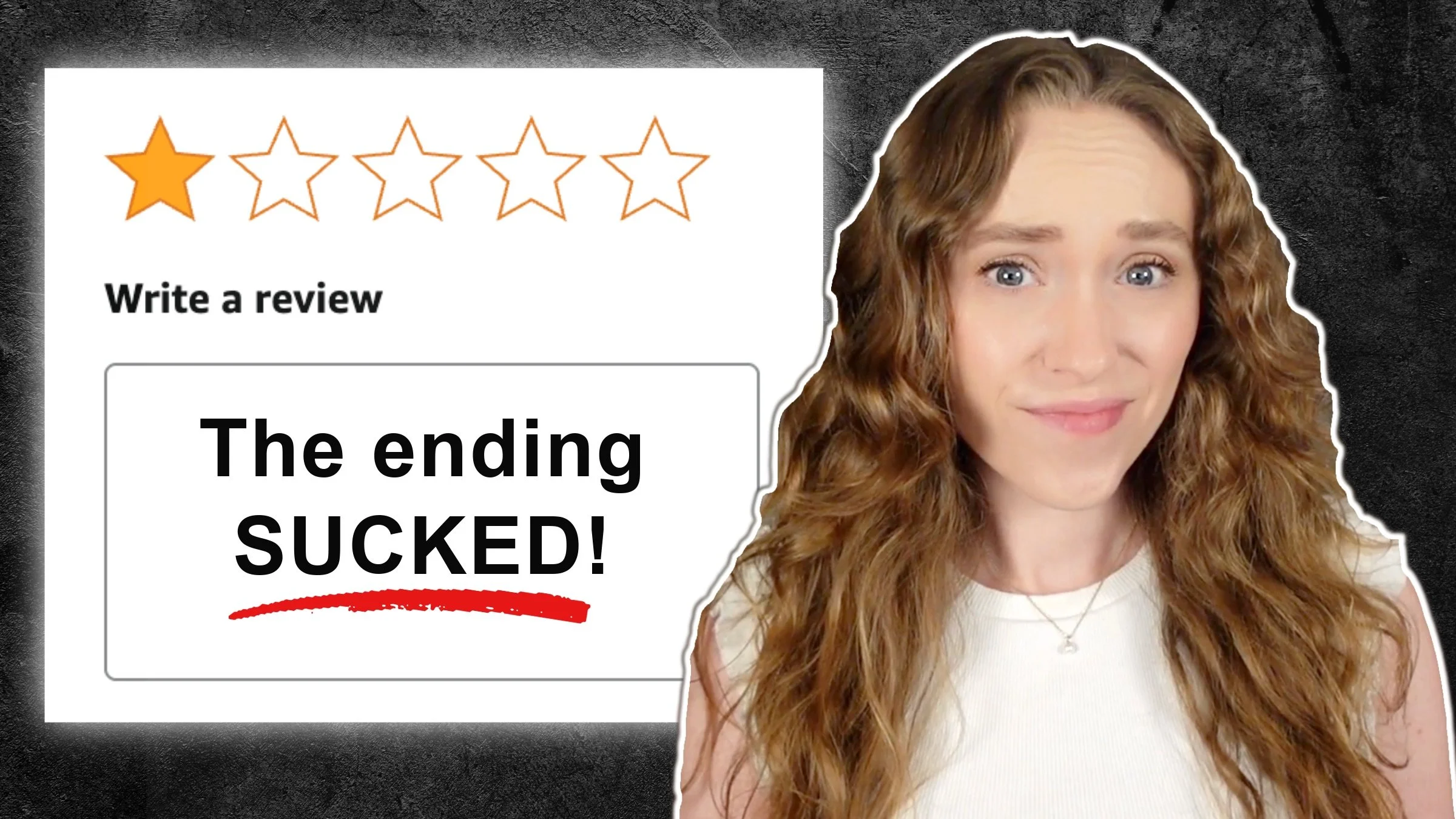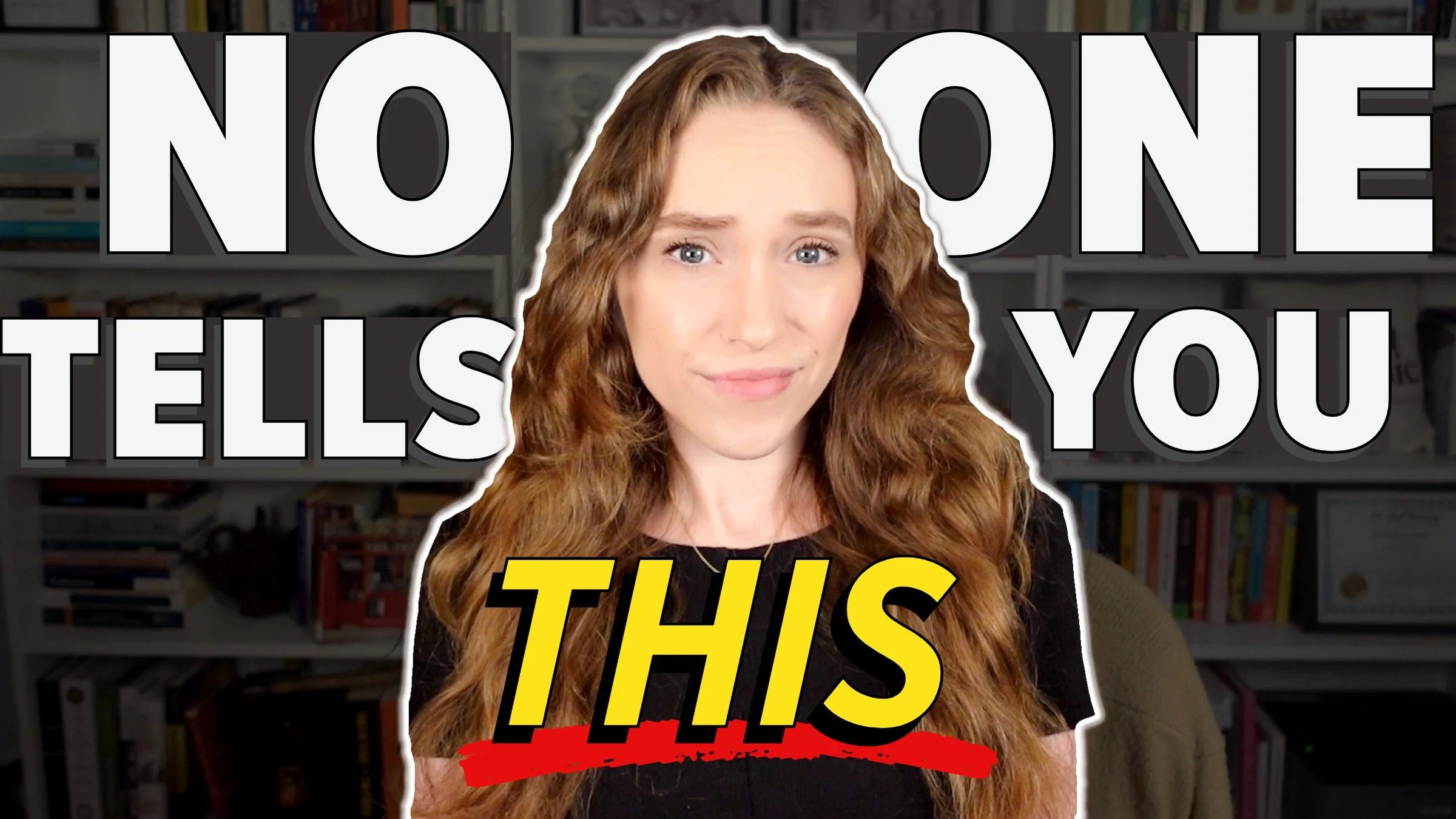7 Bad Novel Endings (and What to Write Instead)
HIT PLAY OR READ THE POST BELOW:
You can write 80,000 brilliant words, but if your ending flops, that's all readers will remember. A bad ending can turn what would have been a five-star rave review into a one-star rant. I've edited hundreds of novels and created a list of the seven weakest endings that ruin otherwise amazing stories.
1. The Overly Sentimental Ending
Here's what it looks like: the couple gets together, gets engaged or married, or even both, and rides off into the sunset. There's no more threat. Everyone gets exactly what they wanted. Life is absolutely perfect. And while that might sound satisfying, it can rob your ending of emotional depth. Because in life, rarely do we get perfect happy endings. Even if we're happy in the moment, we're still typically navigating and grappling with some personal issues. That's the nature of being human.
So, if your ending feels too perfect, if everything is tied up neatly in a bow, and if there's nowhere for your characters to go from here, then it might come across as unbelievable or inauthentic. I'm not saying your characters can't be happy in the end or achieve the objective they set out to. Many novels do end with positive developments, but the endings that pack the most emotional punch are the ones where we know there are still challenges that the characters will face on the horizon, but we trust that they'll be able to navigate them because of everything they've been through. Maybe the couple buys their dream house, but they're still grappling with the loss of a loved one. Or the character scores their dream job, but knows they still have work to do to balance their career and family life.
The strongest endings balance optimism and realism. They acknowledge that the journey is still ongoing. An excellent example of a powerful, emotionally layered ending is Room by Emma Donoghue. The mother and son escape captivity, ending the story with a powerful moment of hope and healing. But the psychological weight of what they've been through isn't swept away. We know they are still navigating their trauma and have a long road to recovery ahead. The strongest endings aren't just happy for the sake of it — they ring as emotionally true. They capture both the beauty and the complexity of life.
2. The WTF Ending
These are the endings that leave readers blinking at the final page, thinking, "Wait, what?" The classic example of this is the it was all a dream ending. The good news is that most authors know that's typically a bad move, so I rarely see it in manuscripts I edit. The bad news is that there are plenty of other ways to deliver a WTF ending that completely derails your story.
If you're introducing a big twist at the end of your book, it has to feel earned. There should be breadcrumbs throughout the story that make the reader say, "Oh, I didn't see that coming, but now it all makes sense." If there aren't enough breadcrumbs and the twist feels like it came out of a totally different book, that's going to be jarring and disorienting — even infuriating for some readers. Your reader is going to feel betrayed and cheated — the exact emotions that spark those nasty one-star reviews.
Take the film Serenity. It starts as a dark, gritty drama about a fishing boat captain, and then out of nowhere, we learn that the captain is actually a character in a video game his son created. It's a twist so extreme that many viewers did not buy into it and felt it ruined the movie. And the reviews show — it has a dismal 21% on Rotten Tomatoes. So, if you intend to end with shock, make sure it works. The twist should feel surprising but inevitable in hindsight, and it should enhance your story's message, not negate it entirely.
3. The Abrupt Ending
This is where your ending is clipped off. The story catapults into the climax, there's a big blowout, and then it just ends. Full stop. There's no reflection, no emotional processing, no space to breathe. The reader turns to the last page and says, "Wait, that's it? There's nothing more." It's a cliffhanger, but not a good one, because it leaves the reader hanging.
So, make sure not to shortchange your ending. Give it enough space on the page. This ending portion of your story after the climax is known as the denouement, and it's an essential component of storytelling. This is where you wrap up loose ends, show how your protagonist has transformed, and give the reader a sense of resolution and closure. That doesn't mean you should linger for chapters on end — more on that in a minute — but if it feels like you just slammed the brakes with your ending, the story is going to crash.
Let's look at an example of this with Avengers: Infinity War. The movie ends right after Thanos snaps away half the universe. We see beloved characters dissolve into dust, and then it fades to black. There's no resolution at all. Now, this particular ending works because it's part of an established franchise and viewers knew there was another movie coming. But in a standalone novel, this type of abrupt, unresolved ending would leave most readers incredibly frustrated. Your ending shouldn't feel like it stops mids—
See what I did there?
4. The Ending That Never Ends
This next bad ending is what happens when you try to do too much — the ending that never ends. This is the ending that overstays its welcome. We reach the climax, but then there are 15 more chapters plus an epilogue. There are no substantial plot developments happening. The story is just dragging on for the sake of it. So, the reader just keeps skimming, thinking, "Why am I still here? When is this going to end?"
Once your reader has already gotten the payoff they came to the story for, there's no reason to keep the story going for longer than necessary. And if your story goes on for too long, that's actually going to undermine any emotional impact you did have, because now you're boring your reader — and that's all they're going to remember.
One example that often gets cited for a drawn-out ending is The Return of the King, the final installment in The Lord of the Rings. It's a beloved classic, but it has like five distinct endings. After the destruction of the ring, we get multiple extended sequences: Aragorn's coronation, the hobbits’ return to the Shire, Frodo's internal struggle and his departure, then Sam's return home to his family. It's all meaningful, but it feels like the story just keeps getting prolonged. One more scene. One more scene.
A great ending knows when to stop. Perfect your pacing, give your reader a sense of closure and then let them go. Don't feel like you need to show us where every single character ends up, because if you keep extending your goodbye, the ending will start to feel like guests at a dinner party who don't know when to leave.
5. The Unnecessary Epilogue
Those of you who can't quite figure out where to end your book might be guilty of this next issue — the unnecessary epilogue. Epilogues are so, so tempting. You want to fast forward 10 years and show us how the characters started a family or opened a business or how their legacy lives on in their grandchildren. But the truth is, many epilogues just aren't needed.
Unnecessary epilogues often feel like you're spoon-feeding things to the reader rather than letting them figure it out for themselves. They overexplain things that the story already resolved and established, or they provide extraneous details that don't change anything. Often, it's far more effective to end your story by resolving the main conflict and then letting the reader imagine where your characters’ lives go from there.
I'm not saying you can never have an epilogue, but if you do, make sure it's essential to the story. It should contribute something new and critical that can't be encapsulated in the main narrative itself. A great example of a strong epilogue is in Atonement by Ian McEwan. The epilogue reveals that the story we just read — a seemingly redemptive tale of two lovers reunited — was actually a work of fiction crafted by the narrator. In truth, the lovers died in war and that happy ending never occurred. This epilogue is effective because it reframes the entire story and is essential to its heart-wrenching impact. It adds a whole new layer to the novel and poses thought-provoking questions about the purpose and power of storytelling.
So, if you have an epilogue, make sure it's actually doing important work and expanding and enhancing our experience of the story. If it's just a “10 years later” update, you can probably cut it out. Sometimes the most powerful thing you can do is leave the characters’ futures unknown.
6. The Obvious Ending
An obvious ending feels like the author just played it safe. This is especially risky in mysteries or thrillers, where the reader expects to be surprised by the ending and will feel dissatisfied if they predict it. If the culprit is exactly who we suspected all along, then your climax is going to lack impact. Your reader will wonder, "What did I just read all of that for?" It will feel like a waste.
The key to avoiding an obvious ending is to subvert the reader's expectations. So, how do you actually do that? In suspense — which I edit a ton of and love — this often involves making the culprit someone that we trust, so we never suspect them until we do. And you'll also want to use red herrings, which is a tactic to divert our attention from the real culprit.
I know what you're thinking — what if readers want and expect an obvious ending? There's a reason Hallmark movies still come around every holiday season. It's true that some genres, like commercial romance, are built on predictable, cookie-cutter endings. We expect the couple to get together in the end, so it's okay that they do. But in those cases, how the couple ends up together is the piece that shouldn't be so obvious. You want to keep the reader guessing as to what will happen next in their relationship, so there is still an element of surprise.
7. The Annoyingly Ambiguous Ending
First things first, ambiguous endings are not inherently bad. Some of the most iconic endings in literature are open-ended by design. Take The Giver, for example. Is Jonas seeing the village meant to signal that he has found a safe refuge and offer a hopeful conclusion? Or is it just a hallucination as he succumbs to the cold? Strategic ambiguity like this works because it's aligned to the novel's core themes.
But annoyingly ambiguous endings just feel lazy rather than intentionally crafted. Sometimes I find that authors think writing an ambiguous ending will make their novel more literary or more thought-provoking and impressive. But first, you should consider whether your reader is actually looking for an ambiguous ending. Some genres lend themselves more toward ambiguous endings than others. In a romance, for example, an ambiguous ending won't land because the reader wants to know for sure whether the couple ends up together or not — they've come to the story for that emotional payoff. Similarly, in a mystery, readers will want to know who the culprit is and won't appreciate you leaving it up in the air. But in a genre like speculative fiction or psychological suspense, ambiguous endings can work really well.
So, think about what your reader is coming to your story for, and then make sure the ending delivers that experience to them. And if you do go for an ambiguous ending, make sure you've provided enough resolution in other areas so the reader is still satisfied. You don't need to give the reader every answer, but you do need to give them the emotional experience they're seeking.






